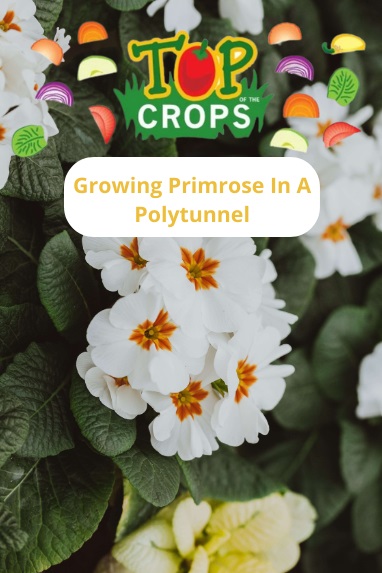There are a huge range of different Primulas, commonly mostly referred to as Primroses and Polyanthus, and Auricula, that you might grow in a polytunnel or elsewhere in your garden.
You will not strictly need a polytunnel to grow these flowers, which will usually be fully hardy and perfectly happy outdoors in our climate here in the UK. But you may wish to grow these pleasing flowers to cheer up your polytunnel, and to bring in bees and other pollinators for your crops.
As long as you provide the right growing conditions and care, these plants can be just as happy inside a polytunnel as they can be outside in a suitable location in a garden.
Primrose refers to the Primula family of flowers, a part of the broader primrose or Primulaceae plant family. Primula comes from the Latin for first to bloom in spring. There are numerous members of this family, all related to the common primrose that most of us are familiar with from spring woodland walks.
Common primrose and other Primulas have been cultivated and hybridized for hundreds of years. You will find a great many different varieties to grow, many of which are easy and unfussy plants.
It is worth knowing that common primroses are also edible! They can be a decorative element to your cakes and other sweet dishes. Add a dusting of caster sugar – and these crystallised primrose flowers are just the most amazing decorations. Primrose leaves are also edible and another addition to your salad. Some people also use the leaves as a garnish on soup.
| Jan | Feb | Mar | Apr | May | Jun | Jul | Aug | Sep | Oct | Nov | Dec | |
| Sow |  |
 |
 |
 |
 |
|||||||
| Plant |  |
 |
 |
 |
 |
|||||||
| Blooms |  |
 |
 |
Primroses on the whole prefer a partially shaded spot, though some types and varieties can do fine in full sun. They do not thrive in a deeply shaded spot.
Most Primula need a moisture retentive soil or growing medium though some are tolerant of drier and more free-draining conditions and others are best grown in bog gardens with saturated soil.
It is important, therefore, to understand the conditions required for the specific primrose or Primula that you wish to grow.
Primroses and Primula in general can be grown in garden beds or borders, or in containers. They can potentially work in a wide range of different settings as long as their basic growing needs are met and their preferred growing conditions are provided.
Primroses can be purchased as small plug plants or bedding plants and planted out in the same way that you would any other plant that you have purchased in this way.
In a suitable location, prepare your planting hole or container. Place the plant into the hole making sure that it is at the same depth it was at in its previous pot, and water it well. Mulch around the plants to retain soil moisture.
To grow primroses or any Primula successfully, you need to understand the specific needs of the plants that you wish to grow. Remember that there are many different plants within this part of the primrose family.
Primulas can be propagated from seed, and some can also be propagated by division of mature plants after they have finished flowering.
The seeds of many varieties of Primula, including certain varieties referred to as Polyanthus and Auricula, should usually be sown between February to April. Some light frost can actually help germination. But you should avoid planting too early.
In colder areas, hold off until April. Sow your seeds any time before the end of May and you should still see some flowers the following year.
Some varieties, however, like Sieboldii, should be sown between November and January outside, then, in February, moved to a shaded cold frame. So make sure you find specific instructions for the exact type and variety you wish to grow.
Cover seeds only lightly because they need light for germination. Note that Primulas can sometimes be sensitive to the mineral salts contained in fertilizer, so be sure to choose a suitable seed starting potting mix to avoid any potential issues.
Most primroses will do best, as mentioned above, in partial shade, or the dappled shade below deciduous trees, rather than in full sun or a deeply shaded location. Some are, however, more tolerant of a sunny position.
Another important thing to remember is that most of the time primroses need a soil that is consistently moist but not waterlogged – a rich growing medium with plenty of organic matter. But remember that there are also some Primula suited to waterlogged conditions.
Remember the habitat from which primroses originally come and in which they naturally grow, and aim to mimic those conditions in your garden for best results.
Consistent moisture can be the most challenging thing to achieve when growing Primula undercover. Make sure that you water well, but for most species, make sure excess water drains away and the conditions do not become waterlogged. Do not allow the soil or growing medium to dry out.
Using an organic mulch around the plants can help to retain soil moisture and keep these plants happy, even when they wont be exposed to rainfall naturally and we must keep watering ourselves.
The Primula most commonly grown in the UK are all hardy plants, with RHS hardiness ratings between H5 and H7. This means that they can be left outside all winter in most/all of the UK even during extreme conditions.
In fact, it is important to note that the plants need a period of winter cold in order to survive and bloom. So it would not be a good idea to keep them inside a heated polytunnel over the coldest part of the year.
When growing primroses indoors or undercover, it is also important to keep humidity moderately high for these plants. Grouping plants together, misting, and damping down on hot days can help.
Native primroses, cowslips and oxlips growing in a natural environment outdoors typically won't need additional feeding in a healthy and humus rich soil. However, when grown undercover, and particularly when growing in a container, feeding many other Primula may be beneficial.
Feed Primula with a dilute, organic, liquid plant feed rich in potassium every ten days or so from when the first buds form until the first flowers open. Then give the plants a final feed once the last flowers die back.
Most Primula will benefit from being repotted and divided to renew older clumps every 2-3 years. When potting up primula, make sure that you place them at the same depth that they were at in their previous position. Water well and use a mulch around the top to conserve moisture.
As mentioned above, most Primula are fully hardy in the UK and can happily withstand a winter outdoors. So you do not need to do anything special to protect them. Most Primula are evergreen or semi -evergreen – keeping a rosette of leaves over the winter months.
If you wish, you may remove older foliage that is looking a bit battered in the winter to keep things looking neat – but this is by no means a necessity.
Most Primula will benefit from deadheading but you should hold off doing so if you wish to collect the seed, or wish the plant to self-seed on its own in your garden. Many Primula do self-seed readily when given the opportunity to do so, especially native species.
There are many Primulas readily available to UK growers. Some varieties that you might consider include:
Native primroses, cowslips and oxlips:
Primula veris
Primula elatior
Primula vulgaris subsp. Sibthorpii
Primula vulgaris 'Taigetos'
Polyanthus varieties:
Primula 'Danova Series'
Primula 'Charisma Series'
Primula 'Crescendo Series – Blue, Bright Red, Pink and Rose Shades'
Primula 'Francisca'
Primula 'Guinevere'
And Auricula:
Primula auricula L.
Primula 'Aire Mist'
Primula 'Broadwell Milkmaid'
Primula 'Clarence Eliot'
Primula x pubescens
All of the above have an award of garden merit from the RHS.
Primroses and other Primula are not particularly prone to many pests or disease problems, and many of the most common problems are those that arise due to deficiencies in the placement of the plants or their care. As long as you place primroses in the right location and care for them correctly you should not encounter many serious problems.
Of course, you do need to look out for certain common pests such as vine weevils, certain caterpillars, and occasionally slugs or snails – though native primroses do not tend to be troubled too much by the last of these, other Primulas may get nibbled a little.
Primroses can also sometimes experience fungal issues. Look out, for example, for Primula leaf spot which causes spots in yellow-orange areas or in grey and papery plant tissues, which can then turn into holes. You may also see white fungal growth below the leaves. Pick off affected foliage as quickly as possible if you see this problem to prevent its spread.
Native primroses work well in natural meadow or woodland schemes, or in a more formal native wildflower bed. But they can, like other primula often used ornamentally, also be grown in pots, which can potentially be placed within a polytunnel as long as there is a partly shaded place for them that will not get too dry or hot.
A polytunnel where the right conditions are provided can make it easier to grow not only the easier natives but also slightly fussier Polyanthus and Auricula types as well.
Just make sure that things don't get too hot and dry in summer, and that the plants are exposed to a period of cold over the winter months and primrose should bloom successfully over several years.
'Primrose', Wildlife Trusts. [online] Available at: https://www.wildlifetrusts.org/wildlife-explorer/wildflowers/primrose
